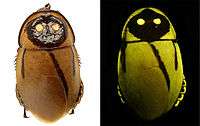Lucihormetica luckae
| Lucihormetica luckae | |
|---|---|
 | |
| Scientific classification | |
| Kingdom: | Animalia |
| Phylum: | Arthropoda |
| Class: | Insecta |
| Order: | Blattodea |
| Family: | Blaberidae |
| Subfamily: | Blaberinae |
| Genus: | Lucihormetica |
| Species: | L. luckae |
| Binomial name | |
| Lucihormetica luckae Vršanský et al., 2012 | |
Lucihormetica luckae is a species of giant cockroach (Blaberidae) from Ecuador.
Light production
Like other species in the genus Lucihormetica, L. luckae's back carapace features one small and two large spots that glow when exposed to light (autofluorescence), perhaps to mimic the appearance of the toxic click beetle (Pyrophorus) that emits light at the same wavelength, in which case this would be an instance of Batesian mimicry.[1][2] The evidence for genuine bioluminescence in Lucihormetica cockroaches is anecdotal and inconclusive,[3][4] though there is evidence for autofluorescence.[5]
Status
The species may be threatened, or even extinct, as only one specimen has ever been collected, some 70 years ago.[6] In addition Tungurahua, the Ecuadorian volcano that served as the species' habitat, entered a new eruptive phase in 1999.[7][8][9]
The species was listed among the Top 10 New Species 2013 discovered in 2012 as selected by the International Institute for Species Exploration at Arizona State University out of more than 140 nominated species.[6][10]
In human culture
The back shell of L. luckae has been noted for its resemblance to Jawas, fictional creatures from the Star Wars science fiction media franchise.[11]
References
- ↑ Vršanský, P.; Chorvát, D. A.; Fritzsche, I.; Hain, M.; Ševčík, R. (2012). "Light-mimicking cockroaches indicate Tertiary origin of recent terrestrial luminescence". Naturwissenschaften. 99 (9): 739–749. Bibcode:2012NW.....99..739V. doi:10.1007/s00114-012-0956-7. PMID 22864963.
- ↑ "Glowing insects evolved surprisingly recently". New Scientist. 21 August 2012. Retrieved 25 August 2012.
- ↑ Greven, Hartmut; Zwanzig, Nadine (2013). "Courtship, Mating, and Organisation of the Pronotum in the Glowspot Cockroach Lucihormetica verrucosa (Brunner von Wattenwyl, 1865) (Blattodea: Blaberidae)". Entomologie heute. 25: 77–97.
- ↑ Merritt, David J. (2013). "Standards of evidence for bioluminescence in cockroaches". Naturwissenschaften. 100 (7): 697–698. doi:10.1007/s00114-013-1067-9.
- ↑ Vršanský, Peter; Chorvát, Dušan (2013). "Luminescent system of Lucihormetica luckae supported by fluorescence lifetime imaging". Naturwissenschaften. 100 (11): 1099–1101. doi:10.1007/s00114-013-1100-z.
- 1 2 Arizona State University College of Liberal Arts and Sciences (22 May 2013). "Top 10 new species of 2012". ScienceDaily. Retrieved 23 May 2013.
- ↑ "Tungurahua". Global Volcanism Program. Smithsonian Institution. Retrieved 1 January 2009.
- ↑ "Look at This: Glowing South American Roaches Mimic Toxic Beetles". Discover magazine. 23 August 2012. Retrieved 25 August 2012.
- ↑ Rudolph, Michael (14 November 2012). "New species of bioluminescent cockroach possibly already extinct by volcanic eruption". mongabay.com. Retrieved 15 November 2012.
- ↑ Newswise (22 May 2013). "Scientists Announce Top 10 New Species". Arizona State University College of Liberal Arts and Sciences. Newswise, Inc. Retrieved 2013-05-23.
- ↑ "These glow-in-the-dark cockroaches look exactly like jawas". io9. 23 August 2012. Retrieved 25 August 2012.
| Wikimedia Commons has media related to Lucihormetica luckae. |
| Wikispecies has information related to: Lucihormetica luckae |